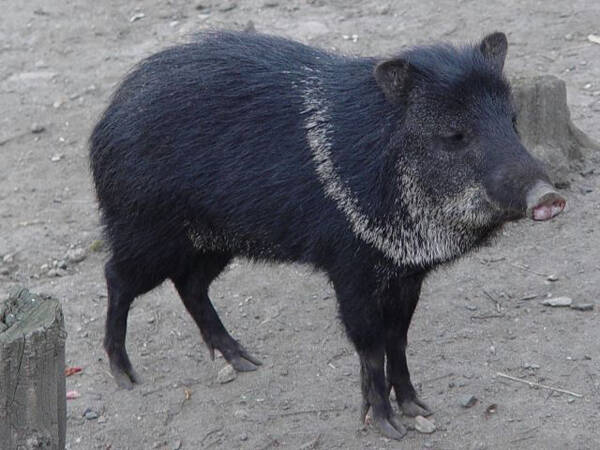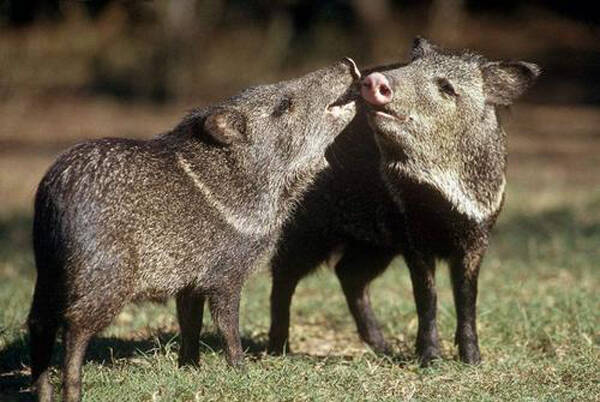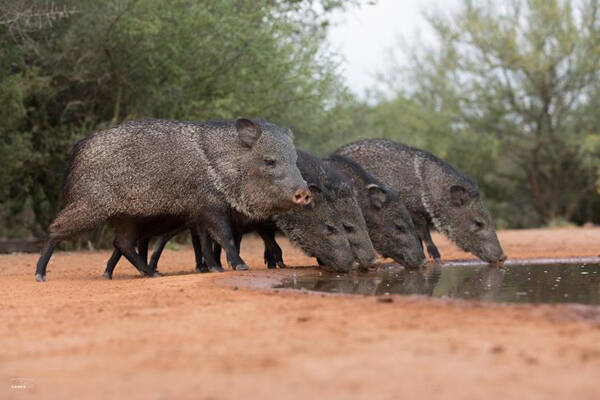Pecari tajacu
IUCN
LCBasic Information
Scientific classification
- name:Pecari tajacu
- Scientific Name:Pecari tajacu,Collared Peccary,Collared peccary, collared pig, collared peccary
- Outline:Ungulata
- Family:Artiodactyla Peccary Peccary
Vital signs
- length:85-102cm
- Weight:15-25kg
- lifetime:About 24 years
Feature
Poor eyesight, but good hearing, and scent glands to repel enemies
Distribution and Habitat
The countries of distribution include Argentina, Belize, Bolivia (Plurinational State), Brazil, Colombia, Costa Rica, Ecuador, El Salvador, French Guiana, Guatemala, Guyana, Honduras, Mexico, Nicaragua, Panama, Paraguay, Peru, Suriname, Trinidad and Tobago, United States (Arizona, New Mexico, Texas), Venezuela and Bolivarian Republic of.
It is found in a wide area from the southwestern United States to Central and South America, from forests, dry forest areas to semi-desert areas. In South and Central America, it inhabits tropical rainforests. In the southern United States, populations occur in cactus deserts, where they prefer leguminous habitats with abundant cacti. It is also common near residential areas and will rely on food distributed by humans.
Appearance
Collared Peccaries are small in size, with adult males standing 0.3-0.5 meters tall at the shoulder, 0.85-1.02 meters long, and weighing 15-25 kilograms. They are often confused with pigs due to their pig-like appearance. They have a large head with a long snout, a rough and tough snout, and only three toes on their hind legs. They have short, straight tusks that curve downward rather than upward, making them powerful offensive weapons. The upper and lower teeth fit tightly together, allowing for good grinding with each jaw movement. The stomach is more complex than that of pigs, with a prominent dorsal gland on the hips, and scent glands that can be used to repel enemies. This is essential in many species-specific behaviors. This species has poor eyesight, but good hearing.
Both sexes are similar in color, with an overall grayish white to black color, with white hair with a yellow tint on the face, shoulders, and throat, a white or yellow ring around the neck, and a long, stiff man
Details
Collared Peccary (scientific name: Pecari tajacu) has 14 subspecies. Peccary, pronounced tuān, means wild boar. Peccary, as the name suggests, is a wild boar in the West. In biological taxonomy, both peccaries and pigs belong to the order Artiodactyla, but they belong to different families.

The collared peccary, like all wild animals of the same family, is a highly social animal that lives in herds ranging from less than 6 to more than 30 individuals. Family groups occupy an average of about 150 hectares, but can range from 24-800 hectares. Variation in home range size between different herds in different regions is not uncommon. In the peninsular Atlantic Forest of southeastern Brazil, home ranges of radio-tracked collared peccaries have been estimated at 102–287 ha, 64–109 ha in northwestern Costa Rica, 460–543 ha on the Brazilian island of Maraca, around 685 ha in Paraguay, and 157–243 ha in French Guia.
Collared peccaries have very close social relationships. They live in particularly cohesive groups of 5–15 individuals. Larger groups of up to 50 individuals have also been reported. Members eat, sleep, and forage together. The exceptions are elderly and infirm individuals, who leave the group to die alone. Herds have a characteristic linear dominance hierarchy, in which males always dominate, while the rest of the order is determined primarily by size. The sex ratio averages 1:1. Social groups are stable, with little overlap between adjacent groups. Feeding subgroups are often formed, sometimes even serving as the initial nucleus from which the original group sheds. Territory size varies from 6 to 1260 hectares, depending on herd size and food availability. Territories are marked by rubbing the rump oil glands against rocks, tree trunks and stumps, leaving an oily fluid. Extensive defecation has also been observed at territory boundaries and is considered marking. Both sexes actively defend the family range. Young adults of collared peccaries fend off enemies by squaring their bodies, lowering their ears, roaring, and using their canines. In combat, they butt heads, hiss, and occasionally lock jaws. Dorsal rump glands are also used for identification. Two family members greet each other by rubbing against each other, moving toward the rump.
Collared peccaries are very dependent on environmental temperature and seasonal changes. Foraging behavior changes significantly from summer to winter, with nocturnal foraging beginning in the evening and ending in the morning as temperatures become more tolerable. The herds even graze during the day to take advantage of the sun's heat. These wild animals are most active in the early morning and late evening. Unlike many mammals, they cannot dissipate heat through panting to prevent moisture from evaporating. During the midday heat, they rest and sleep in the shade of trees.

Collared peccaries keep their herds together through vocalizations and a strong scent released from glands on their backs. Have a diurnal/crepuscular activity pattern, usually feeding in the early hours of the night, but this varies seasonally. Usually rest in small groups of 3-4, often seeking shelter in burrows and under logs. Often roll in mud or dust, rarely spending time grooming themselves. Subgrouping occurs at different spatial and temporal scales compared to White-lipped Peccaries. Typically, a group of Collared Peccaries will gather in large groups in the morning and late afternoon, but will separate into small groups of 1-3 during the day. These subgroups appear to forage separately, 30-250 meters apart. Solitary Collared Peccaries or small groups of 2-3 are frequently reported from sites in tropical areas and the southwestern United States. When the entire group is together, it seems to be more on the move in the early morning and evening. During midday, groups will often stay in relatively restricted areas to forage. They also rest for much of the morning and afternoon, digging out burrows at the base of large trees, fallen tree trunks, or other cool areas.
The collared peccary's diet consists mainly of plants, but it also eats invertebrates and small vertebrates. It has a complex stomach that is capable of digesting rough food. This wild boar eats roots, bulbous plants, beans, nuts, berries, grasses, cacti, agaves, and prickly pears. They usually sleep in caves at night, and often rest under tree roots.
The collared peccary has no specific breeding season, and pups are born throughout the year, depending on food reserves and rainfall. Mating is also related to climate, especially the rainy season, and occurs throughout the year. More pups are also raised during the rainy season. The dominant male does almost all the reproduction. Subordinate males do not have to leave the group, but are not allowed to approach females during the estrus period. Therefore, there are no bachelor groups in this species. The gestation period of females is 141-151 days. The female will leave the group to give birth, as the newborns may be eaten by members of other groups. The average litter is 2-3 pups, and the mother will return to rejoin the group one day after giving birth. The newborn's sister often becomes the new mother's nanny. The pups are able to run a few hours after birth and are weaned at 2-3 months. Males reach sexual maturity at 11 months, and females at 8-14 months. Although the species has a high mortality rate, members can live up to 24 years.

The two main threats to the survival of the collared peccary are overhunting for its meat and hides and excessive destruction of its natural habitat. These factors have led to widespread dispersion of wild boar populations and their extinction in large parts of their former range. The collared peccary and the white-lipped peccary are an important resource for self-sufficiency in the Peruvian Amazon. In Peru, subsistence hunting is legally defined as the use of wild boar meat for domestic consumption or for sale in settlements with fewer than 3,000 inhabitants. Rural residents mainly hunt for meat, with an economic value of about $23 for a collared peccary and $23 for a white-lipped peccary, either as subsistence food or through local sales. Peccary skins are sold as a by-product and have an economic value to hunters of about $5 for collared peccary pelts and $3 for white-lipped peccary pelts. Under a quota system set by the Peruvian government, approximately 51,419 collared peccary pelts and 20,522 white-lipped peccary pelts are legally exported from Peru each year under CITES permits. The pelts are tanned in Peru and sold mainly to the European leather industry for use in the production of high-quality gloves and leather shoes. However, it is unclear whether this trade increases hunting pressure to meet quotas. Furthermore, in order to obtain pelts that meet international trade quality standards, more collared peccaries must be killed (assuming a given number of pelts are rejected due to scars, parasite marks, i.e., zombie flies, and bullet holes). Moreover, considering that wild boar gloves can sell for up to $285, a $5 reward is not a fare trade for collared peccary pelts. On the other hand, increasing the dollar value will certainly increase hunting pressure further.
Listed in the IUCN Red List of Threatened Species 2011 ver 3.1 - Least Concern (LC).
Protect wildlife and eliminate game.
Maintaining ecological balance is everyone's responsibility!








